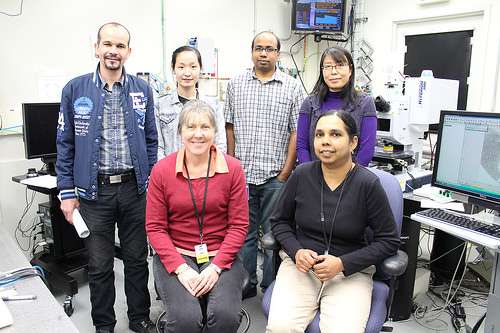Scientists discover the cause of heat tolerance in peas

A recent collaboration between the Canadian Light Source and the University of Saskatchewan Plant Science Department is proving the potential for molecular imaging in plant research that could produce greater yields, healthier varieties, and more food for a hungry planet with a rising average temperature.
U of S plant scientist Dr. Rosalind Bueckert and CLS scientists Dr. Chithra Karunakaran and Dr. Rachid Lahlali used the Mid-infrared beamline to examine the development of pollen grains during the development of two pea varieties exposed to heat stress.
"Over the last century, the average temperature, and specifically the night time temperature, has increased in western Canada," says Bueckert. "This translates into increased frequencies of warm spells during summer. Between three and five days of heat above 28 degrees can cause up to 25 per cent yield decrease in pea crops."
The CLS has other X-ray imaging techniques that are minimally invasive, so imaging of live pea flowers is possible to study the developmental biology. Further, the biochemical changes of any plant part can be tracked throughout its growth cycle.
Bueckert and her group selected two pea varieties and subjected them to heat stress. She then used infrared spectroscopy to track changes in the pea pollen coat and compared that to the reduction in germination in each cultivar.
The spectroscopy results revealed biochemical changes in the plant that explained why one cultivar is more heat resistant than the other.
Karunakaran says, "Before this project, the CLS was often used to study soil chemistry, but that was the extent of our agricultural reach. Now we have demonstrated enormous potential for the CLS to be used to study plants."
The research team has since received funding for the next stages of the project, which will include looking at lipid (oil) chemistry in more detail on a range of pea varieties, with the aim of developing genetic markers for heat tolerance. Canola is also slated for a research project.
"There are exciting opportunities for using the CLS as an agricultural research tool. There are multiple capabilities. We can look at the internal structures of an entire plant, or plant organs such as a flower. We can follow plant development over time, right down to the biochemistry of a single plant cell organ," says Karunakaran.
The benefits of being able to observe a plant at the cellular level as it grows cannot be underestimated. Using chromatography, only one compound could be studied at a time. "Now researchers can watch how proteins, carbohydrates and lipids change and interact throughout the plant, and over time, as the plant develops, using fast and affordable infrared imaging," says Bueckert.
More information: "ATR–FTIR spectroscopy reveals involvement of lipids and proteins of intact pea pollen grains to heat stress tolerance." Frontiers in Plant Science 5 (2014). DOI: 10.3389/fpls.2014.00747
Provided by Canadian Light Source



















